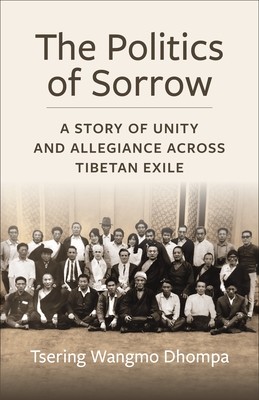
- We will send in 10–14 business days.
- Author: Tsering Wangmo Dhompa
- Publisher: Columbia University Press
- ISBN-10: 023121247X
- ISBN-13: 9780231212472
- Format: 14 x 21.6 x 2.1 cm, minkšti viršeliai
- Language: English
- SAVE -10% with code: EXTRA
Reviews
Description
The Dalai Lama escaped from Tibet in 1959 after its occupation by China and established a government in exile in India. There, Tibetan leaders aimed to bring together displaced people from varied religious traditions and local loyalties under the banner of unity. To contest Chinese colonization and stand up for self-determination, Tibetan refugees were asked to shed regional allegiances and embrace a vision of a shared national identity.
The Politics of Sorrow tells the story of the Group of Thirteen, a collective of chieftains and lamas from the regions of Kham and Amdo, who sought to preserve Tibet's cultural diversity in exile. They established settlements in India in the mid-1960s with the goal of protecting their regional and religious traditions, setting them apart from the majority of Tibetan refugees, who saw a common tradition as the basis for unifying the Tibetan people. Tsering Wangmo Dhompa traces these different visions for Tibetan governance and identity, juxtaposing the Tibetan government in exile's external struggle for international recognition with its lesser-known internal struggle to command loyalty within the diaspora. She argues that although unity was necessary for democracy and independence, it also drew painful boundaries between those who belonged and those who didn't. Drawing on insightful interviews with Tibetan elders and an exceptional archive of Tibetan exile texts, The Politics of Sorrow is a compelling narrative of a tumultuous time that reveals the complexities of Tibetan identities then and now.EXTRA 10 % discount with code: EXTRA
The promotion ends in 22d.18:20:46
The discount code is valid when purchasing from 10 €. Discounts do not stack.
- Author: Tsering Wangmo Dhompa
- Publisher: Columbia University Press
- ISBN-10: 023121247X
- ISBN-13: 9780231212472
- Format: 14 x 21.6 x 2.1 cm, minkšti viršeliai
- Language: English English
The Dalai Lama escaped from Tibet in 1959 after its occupation by China and established a government in exile in India. There, Tibetan leaders aimed to bring together displaced people from varied religious traditions and local loyalties under the banner of unity. To contest Chinese colonization and stand up for self-determination, Tibetan refugees were asked to shed regional allegiances and embrace a vision of a shared national identity.
The Politics of Sorrow tells the story of the Group of Thirteen, a collective of chieftains and lamas from the regions of Kham and Amdo, who sought to preserve Tibet's cultural diversity in exile. They established settlements in India in the mid-1960s with the goal of protecting their regional and religious traditions, setting them apart from the majority of Tibetan refugees, who saw a common tradition as the basis for unifying the Tibetan people. Tsering Wangmo Dhompa traces these different visions for Tibetan governance and identity, juxtaposing the Tibetan government in exile's external struggle for international recognition with its lesser-known internal struggle to command loyalty within the diaspora. She argues that although unity was necessary for democracy and independence, it also drew painful boundaries between those who belonged and those who didn't. Drawing on insightful interviews with Tibetan elders and an exceptional archive of Tibetan exile texts, The Politics of Sorrow is a compelling narrative of a tumultuous time that reveals the complexities of Tibetan identities then and now.

Reviews